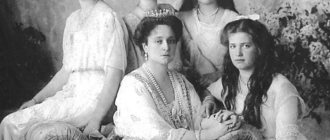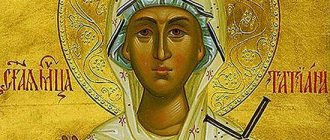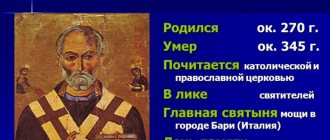Grand Duchess Tatiana Nikolaevna 1915.
Princess Tatiana Nikolaevna Romanova is the second eldest daughter of Emperor Nicholas II and his wife Alexandra. She was born less than 2 years after Olga - on May 29, 1897, in the Alexander Palace. The empress's second pregnancy was also not easy. According to doctors' records, due to the threat of miscarriage, Alexandra spent about 7 weeks in bed, getting up only on January 22, 1897. The birth of Tatiana was a great disappointment for the people and courtiers - everyone was waiting for the appearance of an heir. Prince Konstantin Konstantinovich wrote in his diary:
“In the morning God gave Their Majesties... a daughter. The news spread quickly and everyone was disappointed as they were expecting a son.”
The newborn was given a name uncharacteristic for the Romanov family. This was due to the desire of Nicholas II to name his daughters the same names as the heroines of Pushkin’s “Eugene Onegin”. The difficult pregnancy did not affect the baby’s health – the girl developed and grew absolutely normally.
New information after 100 years
Remains of the royal family./ Photo: kolybel-ural.ru
Over the past few years, sensational, unexpected and contradictory versions of what happened on the fateful night have begun to appear in periodicals and on the Internet. We are talking about staging an execution, taking the royal family abroad, and even ritual murder. Research, including genetic testing, is still ongoing. Perhaps soon the undeniable truth of the fate of historical figures will become known to society.
The princess's childhood
Tatyana Romanova in her youth./ Photo: elitsy.ru
It is no coincidence that the name of the Tsar’s daughter coincides with “Pushkin’s” Tatyana. The eldest daughter of the Romanov spouses is Olga, the youngest is Tatyana - well-known names of the heroines of the famous “Eugene Onegin”.
Tatyana Romanova in full military uniform./ Photo: tumblr.com
It is interesting that the characteristic features of the two matured Tatianas intersect: high self-control, fortitude, majestic calm, a highly developed sense of duty.
At a picnic./ Photo: turizmvnn.ru
However, you should not go deeply into such lyrical comparisons, or even into any other comparisons of the princess with this or that person. 1897 May 29, Peterhof - the day and place of birth of the Grand Duchess.
Sisters./ Photo: fashiony.ru
If the expression “beloved daughter” could be figuratively applied to the royal family, it would be Tatiana. The princess’s balanced character was evident from an early age. The girl loved quiet games, needlework, and books.
Tatyana Nikolaevna reading a book./ Photo: fanpop.com
The concept of a playful child did not apply to her in any way. A smile did not often play on her lips. This soulful gaze of a wise child will not lose its depth until the end of its short life. A concentrated facial expression, slightly sad eyes, a tall, well-built figure, and hard work are the most common characteristics that can be found in letters from contemporaries who knew her personally.
Princess Maria
Maria Nikolaevna Romanova, Holy Princess
When Alina Karamidas, who lived in South America, lived to a ripe old age, her family heard that she began to speak Russian. The linguist translated the following. She claimed that she was born in Russia and was Princess Romanova, who at one time escaped execution. Children and grandchildren have been looking for evidence of grandmother Alina’s words for a long time, but in vain. At the beginning of 1919, a girl with a regal bearing and secular manners appeared in a Polish village. Her name was Averis Iacovelli. Rumors began to appear around that it was Maria Nikolaevna Romanova who miraculously survived. The girl did not comment on these statements. She lived quietly and secludedly. However, after her death, diaries were discovered, entries in which showed an identity with the princess. The contender for the title of Russian princess Maria Marti openly stated that she was born Maria Romanova. Her children still point to the identity of the handwriting of their mother and the Grand Duchess of Russia. They even opened a page on the Internet, where they gathered many supporters of their version.
Start of the war
Grand Duchess Tatiana Romanova./ Photo: keywordsuggest.org
The horrific events of the First World War found the princess at the age of seventeen. Meanwhile, the young princess had already formed concepts at the state level. Both parents could and loved to talk with her on such topics. Of course, the daughter’s active nature was not limited to communication in the palace. During war, people suffer - this is a fact. The Tatyana Committee, an organization whose chairman was Romanova, was involved in helping such people (refugees, others affected by military events).
Olga
Princess Olga.
The most famous and successful of all the scammers who called themselves Olga Nikolaevna Romanova was, perhaps, Marga Boodts. At the beginning of World War II, she settled in France, playing the role of the miraculously escaped execution and impoverished daughter of the murdered Russian Emperor. For a long time, the Romanov impostor collected significant sums from gullible and sympathetic citizens. Such alms provided Marga with a far from poor existence and some privileges in Parisian society. Her fraud was exposed, and the swindler appeared in court.
Swindler Marga Boodts.
After serving her sentence, she somehow miraculously managed to convince Crown Prince Wilhelm and other high-ranking members of the Romanov tree of the veracity of her version, who provided her with a substantial pension for the rest of her life and gave her a luxurious villa in Italy. Recalling the events of that terrible night in the Ipatievs’ house, Marga said that she was saved by a simple peasant woman, replaced by an orphan girl who did not even suspect that in a few hours she would be shot. False Olga claimed that except for herself, no one from the royal family managed to escape. In the early 90s of the last century, Russian criminologists reconstructed the faces of the royal family based on skulls found in the supposed place of their burial. And many previously classified materials on the royal family case remain very controversial. But still, in this bitter story there are many dark spots that make you wonder: were all the false Romanovs swindlers?..
Canonization by the Church
Icon “Holy Royal Passion-Bearers.”/ Photo: kolybel-ural.ru
Disagreements continue over the issue of canonizing seven family members as “royal passion-bearers.” A significant event occurred only in the recent year 2000 after “long deliberation.” BONUS
Why... / Photo: elitsy.ru
Years passed and swindlers began to appear who appropriated the imperial family for themselves.
Emperor Nicholas II with his wife and children.
In 1918, the Bolsheviks sentenced the royal family without trial. The Romanovs were shot at dawn on July 17, finished off with bayonets, the remains were doused with sulfuric acid and buried. This brutal murder soon began to become overgrown with rumors and legends, which were composed by swindlers trying to prove their involvement in the imperial family. Almost all the false Romanovs were convinced that they miraculously managed to escape execution in the house of engineer Ipatiev, where one of the most monstrous atrocities in the history of Russia took place.
Tsarevich Alexey
Tsarevich Alexei.
Some time after the execution of the royal family, a certain Alexei Putsyato appeared before Admiral Kolchak and told him that when the train was leaving on which the Romanovs were being taken into exile, people sympathetic to the tsar organized his escape, the heir to the throne. They helped Alexei hide for several months. But the swindler was immediately exposed, since one of the Tsarevich’s teachers was alive, and brought the impostor to clean water.
Alexey Putsyato is the first impostor exposed by the crown prince’s teacher.
For a long time, a certain Philip Semyonov convinced those around him of his “royal origin.” He even told details from his palace life. In the end, he was placed in a psychiatric hospital, where the other Napoleons and Macedonians were kept.
Philip Semenov - Tsarevich from the colony.
Estonian Eino Tammet put forward the following version of his salvation. Yurovsky, who led the group of reprisals against the royal family, used blank cartridges when shooting at him, the king’s son. Then, while transporting the bodies to the burial site, Alexei fled and was handed over to a family of distant relatives of the Tsar's courtiers who lived in Estonia.
Eino Tammet is an impostor of Estonian origin.
Having reached adulthood, he left for Canada. Currently, his heirs continue to lay claim to the Romanov family and the royal crown. Nikolai Dalsky, proving that he was Alexei Romanov, claimed that under the guise of an assistant to the tsar’s cook, guards sympathetic to the monarchists took him from the place of detention of the royal family to the city of Suzdal, to the family of a certain Dalsky, whose son, the same age as the Tsarevich, died at that time. There, the “heir to the throne” was allegedly cured of hemophilia. Later he became a Red Army officer. In total, at different times there were 81 impostors who impersonated Tsarevich Alexei.
Anastasia
Princess Anastasia.
The most discussed personality from the Romanov dynasty. It is she who is credited with the accidental rescue from the Ural dungeons, and the number of impostors in this case is colossal. One of the Anastasias was a certain Anna Anderson, her real name was Francis. When she was admitted to a Berlin psychiatric hospital, in her delirium she called herself Princess Romanoff. One of the nurses saw the girl’s striking resemblance to the favorite of Nicholas II. Russian emigrants readily supported this myth, and for twenty years the impostor tried to prove her royal origin through the courts. She accurately described the situation in the palace, the servants, household items and various little things that confirmed her version. Anderson's supporters still consider her to be the only surviving member of the imperial family.
Anna Anderson.
Nadezhda Ivanova-Vasilieva, while in a psychiatric hospital in the city of Kazan, said that she escaped from the Ipatievs’ house by seducing a security officer. Proving her involvement in the royal family, she went on a hunger strike. Later she was sentenced to death by the NKVD for conducting underground monarchist activities. Eugenia Smith, a famous American artist, author of the book “Anastasia,” which is supposedly an autobiography of the Grand Duchess. Smith fantasized so inspiredly that she herself believed in the authenticity of what happened to her in her youth. Which, in fact, is very typical of creative people. But the impostor did not pass the polygraph test.











